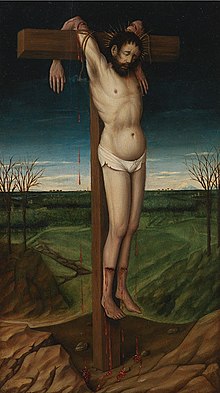Penitent thief
Other traditions have bestowed other names: Two men were crucified at the same time as Jesus, one on his right and one on his left,[10] which the Gospel of Mark interprets as fulfillment of the prophecy of Isaiah 53:12 ("And he was numbered with the transgressors").[14] Later commentators, such as Frederic Farrar, have drawn attention to the difference between the Greek words used: "The two first Synoptists tell us that both the robbers during an early part of the hours of crucifixion reproached Jesus (ὠνείδιζον), but we learn from St Luke that only one of them used injurious and insulting language to Him (ἐβλασφήμει)."[15] The phrase translated "Amen, I say to you, today you will be in paradise" in Luke 23:43 ("Ἀμήν σοι λέγω σήμερον μετ’ ἐμοῦ ἔσῃ ἐν τῷ παραδείσῳ."[16] Amén soi légo sémeron met' emoû ése en tôi paradeísoi) is disputed in a minority of versions and commentaries.[18][19][20] According to the United States Conference of Catholic Bishops commentary on John 18:40, the term commonly translated as thief – léstés[23] – can also mean "a guerrilla warrior fighting for nationalistic aims."[24] Luke's unnamed penitent thief was later assigned the name Dismas in an early Greek recension of the Acta Pilati and the Latin Gospel of Nicodemus, portions of which may be dated to the late fourth century.In the Roman Martyrology, the following entry is given: "Commemoration of the holy thief in Jerusalem who confessed to Christ and canonized him by Jesus himself[26] on the cross at that moment and merited to hear from him: 'Today you will be with me in Paradise.'"Here the good thief is apparently located to the right side of Jesus, similar to the famous late sixth-century depiction of the crucifixion in the Rabbula Gospels.In medieval art, St Dismas is often depicted as accompanying Jesus in the Harrowing of Hell as related in 1 Peter 3:19–20 and the Apostles' Creed (though neither text mentions the thief).In Samuel Beckett's Waiting for Godot, the main characters Vladimir and Estragon briefly discuss the inconsistencies between the Four Evangelists' accounts of the penitent and impenitent thieves.In the 1967 romantic comedy caper film Fitzwilly, butler mastermind Claude Fitzwilliam (Dick Van Dyke) and his larcenous staff operate St. Dismas Thrift Shoppe in Philadelphia, a fictional charity where they send and store their stolen loot.In Poul Anderson's Technic History (a science fiction story cycle), Nicholas van Rijn (2376 to c. 2500), CEO of Solar Spice and Liquors keeps a Martian sandroot statue of Saint Dismas, to whom he frequently burns candles.



Dysmas (name)The Good ThiefArab ChristianBerlin State MuseumGalileeHerodian Kingdom of JudeaRoman EmpireGolgotha HillJerusalemCrucifixionCatholic ChurchEastern Orthodox ChurchOriental Orthodox ChurchCanonizedJesus ChristshrineChapel of Saint HelenaChurch of the Holy SepulchreAttributesloinclothParadisePatronagecondemnedFuneral directorsMerizo, GuamSan DimasMexicoChurch of Saint DismasDannemoraNew Yorkcrucifixion of JesusNew TestamentGospel of Lukehis kingdomimpenitent thiefRoman MartyrologyFeast of the AnnunciationincarnationGospel of NicodemusCoptic OrthodoxNarrative of Joseph of ArimatheaCodex ColbertinusArabic Infancy GospelRussian OrthodoxRussianGospel of MarkIsaiah 53MatthewTatianDiatessaronEphrem the SyrianOrigen of AlexandriaEustathius of AntiochEpiphanius of SalamisAmbrose of MilanAugustine of HippoFrederic Farraradverbword orderKoine GreekBible translationsAramaic languageCuretonian GospelsThomas AquinascrucifixestitulusPontius PilateJohn ChrysostomPope Gregory IfratricideUnited States Conference of Catholic BishopsGestasSyriac Infancy GospelAnne Catherine EmmerichPeter Damianthe Holy FamilyPope Theophilus of AlexandriaHomily on the Crucifixion and the Good ThiefCoptic literatureJosephflight into EgyptSan Dimas, Californiaparish churchesKingston, OntarioKingston PenitentiaryWaukeganOld CatholicCoseleyChurch of St. Dismas, the Good ThiefClinton Correctional FacilityGood FridaySynaxarioneucharistChurch SlavonicMatinsseraphSolovetsky Monasterymedieval artHarrowing of HellApostles' CreedSamuel BeckettWaiting for GodotFour EvangelistsThird DayDizmasSydney CarterFriday MorningStelio SavanteNathan DrakeRacionais MC'sThug LifeDarkest DungeonFitzwillyDick Van DykeThe Hoodlum SaintWilliam PowellEsther WilliamsAngela LansburyJohn LescroartSan Dimas High SchoolBill & Ted media franchiseClerks IIIrunning gagPoul AndersonNicholas van RijnKa’s